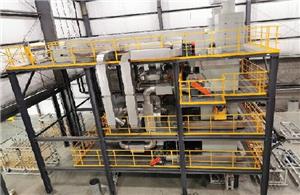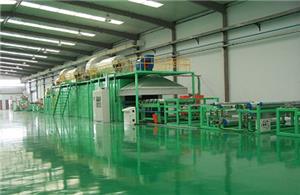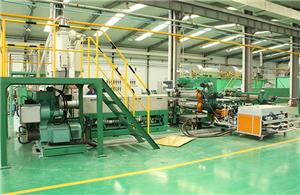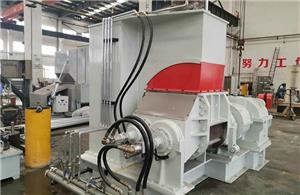Introduction to the extrusion molding principle of XPE foam and IXPE foam motherboard and the working process of the extruder
Recently, a friend asked about selecting an IXPE extruder and wanted to know the differences between the extrusion modes of IXPE and other extruders. The following is a summary for reference by colleagues who are considering working with XPE foam or IXPE foam.
Ⅰ. XPE foam and IXPE foam mother sheet extrusion molding principle
XPE foam and IXPE foam master sheet extrusion molding is a process in which the mixed raw materials of XPE and IXPE are extruded through the screw and barrel of the XPE foam and IXPE foam master sheet extruder to uniformly plasticize the raw materials such as PE, and then forced through the die of the XPE foam and IXPE foam master sheet extruder to become a continuous product with a certain width and thickness.
XPE foam and IXPE foam mother sheet extrusion principle:
PE, AC, and other auxiliary raw materials are fully mixed and enter the barrel from the hopper. Under the action of the screw rotation of the XPE foam and IXPE foam master sheet extruder, they are transported forward to the feeding section through the friction and shearing effect between the inner wall of the barrel and the screw surface. Here, the loose solids are transported forward and squeezed and compacted. In the compression section, the depth of the screw groove becomes shallower, further compacting the material. At the same time, the external heating of the XPE foam and IXPE foam master sheet extruder barrel and the friction and shearing effect between the screw and the inner wall of the barrel increase the material temperature and begin to melt, marking the end of the compression section. The homogenization section makes the mixture uniform and stabilizes the temperature. The metering section extrudes the mixture at a fixed quantity and constant pressure to melt. After passing through the T-die, the mixture is formed and cooled to form the XPE foam and IXPE foam master sheet products.
Ⅱ. XPE foam and IXPE foam Screw structure of mother sheet extruder
Generally, the screw of XPE foam and IXPE foam masterbatch extruder adopts a three-section screw. The specific functions and effects of each section are as follows:
1. Feeding Section: Responsible for conveying mixed solids such as PE. After PE, AC, and other mixed plastics enter the barrel from the extruder's hopper, they are gradually pushed toward the die head as the screw of the XPE foam and IXPE foam masterbatch extruder rotates. In the feeding section, the screw channel is filled with loose PE solid particles (or powder), and the material begins to be compacted.
2. Melting Section: When the PE and other mixed materials enter the compression section, the gradually shallowing screw groove and the resistance of the die head, porous plate, and filter screen create a very high pressure on the materials in the barrel of the XPE foam and IXPE foam master sheet extruder, compacting the materials. At the same time, the temperature of the plastic gradually rises due to the external heating of the barrel and the internal friction heat generated by the mixing and shearing of the screw and barrel. For a conventional three-stage full-thread screw, the material temperature reaches the viscosity flow temperature at a point where it meets the barrel wall about 1/3 of the way through the compression section, and begins to melt. As the mixed material is continuously transported forward, the amount of melted material gradually increases and the amount of unmelted material decreases. At about the end of the compression section, all the material melts and turns into a viscous flow state, but the temperature of the material at each point is still not uniform.
3. Homogenization and metering: After the homogenization in the homogenization section, the material temperature becomes relatively uniform. Finally, the screw squeezes the molten material into the T-die at a constant quantity, pressure and temperature to become XPE foam and IXPE foam mother sheets.
Ⅲ. XPE foam and IXPE foam mother sheet extruder equipment composition
The XPE foam and IXPE foam master flake extruder molding equipment consists of an extruder, a T-die, and auxiliary cooling and molding equipment.
The main unit of the XPE foam and IXPE foam master flake extruder is the extruder, which includes an extrusion system, a transmission system, a heating and cooling system, a traction device, a trimming and winding device, and a control system.
1. Extrusion system: The extrusion system includes a hopper, screw, barrel and T-die. The XPE and IXPE mixed masterbatch is plasticized into a uniform melt through the extrusion system and is continuously extruded out of the die by the screw under the pressure built up in this process.
(1) Hopper: The hopper is a temporary storage bin for feeding XPE foam and IXPE foam masterbatch extruders. XPE and IXPE mixed masterbatch is stored in the hopper and enters the extruder feed section through the feeding port at the bottom. A cut-off device is installed at the bottom of the hopper to adjust and cut off the material flow. The side of the hopper is equipped with a sight glass and a calibration metering device.
(2) Screw: It is the most important component of the XPE foam and IXPE foam mother sheet extruder. It is directly related to the extrusion quality and productivity of the XPE foam and IXPE foam mother sheet. It is made of high-strength and corrosion-resistant alloy steel.
(3) Barrel: This is a metal cylinder with high heat and pressure resistance. It is made of strong, wear-resistant, and corrosion-resistant alloy steel or a composite steel pipe lined with alloy steel. The barrel works with the screw to crush, soften, melt, plasticize, and compact the XPE foam and IXPE foam masterbatch, and continuously and evenly transport the molten material to the molding system. For XPE foam and IXPE foam, the barrel length is generally 25 to 30 times its diameter, so that the mixed plastics such as PE and AC are fully heated and plasticized.
(4) Mold: The XPE and IXPE mixture is evenly and smoothly conveyed into the mold by the screw, and a certain molding pressure is applied to the molten XPE and IXPE mixture. The molten XPE and IXPE mixture is plasticized and compacted in the barrel, and flows through the porous filter plate along a certain flow channel through the head neck into the molding mold, forming an IXPE and XPE membrane sheet of a certain width and thickness. To ensure uniform membrane thickness, multiple adjustment bolts are usually installed on the die head, and the membrane thickness can be adjusted by adjusting the degree of pressure of the adjustment bolts.
2. Transmission system: The function of the transmission system is to drive the screw of the XPE foam and IXPE foam mother sheet extruder and provide the torque and speed required by the screw during the extrusion process. It is usually composed of a motor, a reduction box and bearings.
3. Heating and cooling devices: Heating and cooling are necessary conditions for the extrusion process of XPE foam and IXPE foam mother sheets.
(1) Current XPE foam and IXPE foam mother sheet extruders usually use electric heating, which is divided into resistance heating and induction heating. The heating plates are installed on the machine body, machine neck, machine head, and mold. The heating device is located outside the barrel. By heating the barrel, the PE plastic inside the barrel is heated, causing the PE plastic to reach the temperature required for the process operation.
(2) Cooling device: This device is designed to ensure that the XPE and IXPE masterbatch mixture is within the temperature range required by the process. Specifically, it is used to remove excess heat generated by the shear friction of the screw rotation to prevent the AC from decomposing, burning, or causing difficulty in shaping due to excessive temperature. Barrel cooling can be divided into water cooling and air cooling. Generally, XPE foam and IXPE foam masterbatch extruders use a combination of these two types of cooling. Screw cooling mainly uses central water cooling, which aims to increase the material solid conveying rate, stabilize the output of the glue, improve product quality, and reduce the risk of pre-foaming.
4. Pulling Device: After thermoplastics are extruded through the die, the cross-section of the extrudate differs from the cross-sectional shape and dimensions of the die due to the dual effects of thermal contraction and expansion after release. Furthermore, as the product is continuously extruded, its mass increases. Without a pulling mechanism, it will accumulate and stagnate. Therefore, the extrudate must be pulled out continuously and evenly to ensure the continuity of the extrusion process and to adjust the cross-sectional dimensions and properties of the extruded profile. The function of the XPE foam and IXPE foam master sheet extruder is to evenly pull the molten XPE foam and IXPE foam master sheet from the T-die, controlling and shaping the thickness of the XPE and IXPE master sheet products.
5. Trimming and winding device: After the XPE foam and IXPE foam products are shaped and cooled, they are trimmed according to the required width, and are wound and cut according to the required length (weight) and rolled into XPE foam and IXPE foam mother sheets.
6. Control system: controls the main and auxiliary machine's traction motors, drive oil pumps, oil (steam) cylinders and other various actuators of the XPE foam and IXPE foam mother sheet extruder, and allows each actuator to operate according to the required power, speed and trajectory; at the same time, it detects and controls the temperature, pressure and flow of the main and auxiliary machines to achieve automatic control of the entire extruder unit and control of product quality.
This is the working principle and structural composition of XPE and IXPE master sheets EXTRUDER. I hope this knowledge will be helpful to all friends who are about to engage in XPE and IXPE foam industry.




